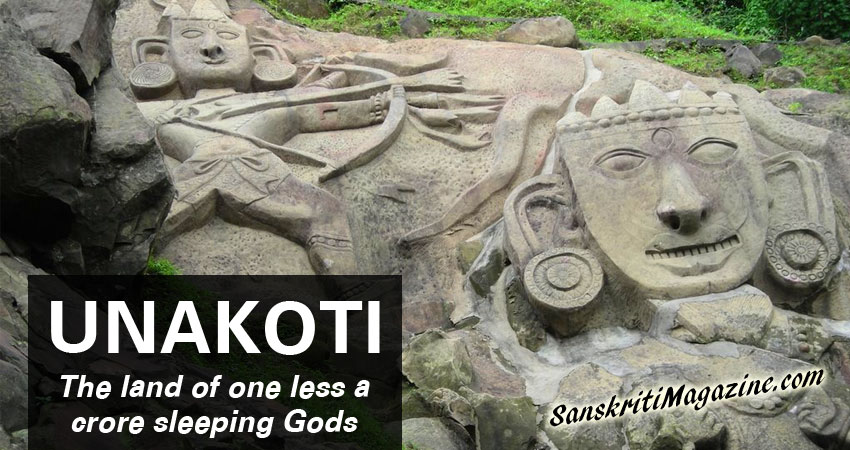A mountain, and on the sides of it carved out stone images, a spring descending in the rivulet, a place of archeological wonder Unakoti in Tripura is unparalleled. One wonders who those people were and at what spell of time did they chisel out such wonderful idols from the rocks . The sculptors and the point of time has remained obscure till date. Yet on seeing these eternal works of art people could not help pay their respect to those sculptors. Unrecorded in history, a mystery surrounds Unakoti and that definitely fascinates visitors.
Unakoti is situated at a distance of 10 kilometres from the North District headquarters, Kailashahar. The road was inaccessible four decades ago. One had to come all the way on foot passing through deep jungles and crossing over mountains. The scenario changed after the road connection was established. A diversion road runs from Dharmanagar-Kailashahar connecting road upto the place of pilgrimage.On the hilly terrain many idols of gods and goddess are lying scattered. At the main peak there are idols of Uma-Maheshwar, five-faced Shiva, Vishnu, Ganesha, Hanuman and Ravana. Among the carved-out images on the rocky fringes those of Ganesha and Shiva are prominent. This image of Shiva as Lord of Unakoti (Unakotiswar) is famous as Kal-Bhairava. Goddess Durga is also carved on the side of the hill. The four-faced idol of Unakoti is known to all though the fourth face was damaged long back.
According to the archeological department, the Shiva idols of Unakoti date back to the 8th or 9th century. Some also opine that this holy place was the Shaiva-Tirtha of the Pal-era. Others consider that these might have been worked out even before that period. Some others think that these idols were sculpted by master sculptors elsewhere and were brought in Unakoti with great care. There is no let up in research work on Unakoti idols. But all come to the same conclusion that the idols and images of Unakoti were not made in one particular spell of time. These were worked out in different periods of time and, therefore, these were influenced by different religious sects. Some archaeologists opine that these were of the period of Pal dynasty, as a Shaiva Tirtha, others have traced it as a Buddhist meditation centre. Hence, Unakoti is also seen as a symbol of religious unity.
Huge sculptures were chiseled out from the rock-sides and the images were carved. Of course, those suffered damage in the earthquakes and natural calamities. A beautiful spring is descending down the hill terraces. This has filled up the cavern, called “Sitakund” and then danced down in sprightly pace. This resulted in the origin of a modest pond (cherra) with sparkling water which is cool and refreshing. Every year during Ashokastami and Makar Sankranti big fairs are held at Unakoti. Peoples from far and near come there for a holy dip in Sitakund.
Religious Significance
There are many hearsays about Unakoti, the place of pilgrimage. The name Unakoti is derived form the thought that there was an assembly of gods and goddesses numbering one less than a crore . At a point of time the Lord of the gods, Mahadeva accompanied by the gods started for Benaras (Varanasi). When they reached at Raghunandan Hill, they decided to spend the night at the place and then start for Varanasi the next morning. But in the hours of dawn, only Mahadeva woke up. Then the Lord of the gods left for the destination alone; while all other gods and goddesses turned in stone images as they were fast asleep.
Another story revolves around one Kalu Kamar, the famous sculptor. He was assigned the task to build a crore of the deities in his dream. But keeping the last idol unfinished Kalu created his own image. Thus ‘Koti’ could not be completed. So, the place got its name as Unakoti.
The history of old Kailashahar is also associated with Unakoti. A 15th generation descendant of King Jujhar Fa, a Shiva disciple who started the Tripurabda (Tripuri Calendar), prayed for Lord Shiva in a village called Chhambulnagar on the banks of the river Mau. It is speculated that Chhambulnagar, which is mentioned in Rajmala, was situated near Unakoti Hill. The Prince prayed for Mahadeva in Unakoti. For this some people believe that the previous name of Kailashahar was Chhambulnagar. Some believers thought that Har (Shiva) resides in Kailash. Therefore the place was known as Kailash Har which was later on transformed to Kailashahar. A Tripura king named Adi-Dharmapha ruled here in 7th century. He performed a great yagna with much pomp and gaiety. The name Kailashahar found currency since that time.
Unakoti has been included in the tourism map of Tripura and the North-East as a remarkable tourists’ resort. Common pilgrims frequent the place. Tourists from far and wide also converge in Unakoti with much enthusiasm. One can have a trip to Unakoti via Kailashahar or Dharmanagar. The journey takes 20 minutes from Kailashahar and 45 minutes from Dharmanagar.
Who created such marvelous rock carvings and the stone images of gods and Goddesses in such a deep forest hundred years ago is indeed a mystery. Why this secluded hilly place was selected for the purpose is not known.But the place is still accessible. But mystery still revolves round Unakoti. The hilly forests, the spring, chirping of birds, the carvings in stones and rocks, the leisurely – scattered idols and hearsay have given a special significance to Unakoti.
~ Pannalal Roy, Author, Researcher and Historian


















